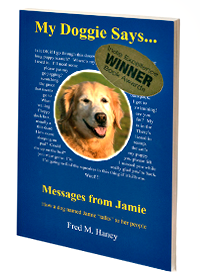Hi, this is Callie writing. Fred’s in Philadelphia for a few days, so I’m filling in.
Here are ten ways that owning a dog can make you a healthier person:
- Dogs need daily exercise. So if you take your dog for a walk every day, you’re getting your own needed exercise, which helps you manage your weight and stay healthy.
- Busy people are happy people. Sure dogs take some time. But it’s good discipline to manage your time better.
- A dog will lick your wounds and help them heal. A dog’s saliva contains some anti-septic stuff.
- Dogs help you make friends. It’s pretty hard to take a cute dog on a walk without meeting new dogs and people. Everyone likes to stop and say “hello†to a dog. You’ll meet more people, too.
- Dogs are good psychologists. Ever notice what good listeners they are? And don’t you feel better after telling your dog about your problems?
- Remember, dogs are “Man’s Best Friend.†It’s healthy to have friends – people friends and dog friends.
- Some people need to learn how to train their dog and work with it. Going to a puppy training class can be a great experience. You meet new people and dogs. And you learn a lot about dogs. And we all know that learning is healthy.
- Who knows? Maybe someday you’ll write a book about your dog, like Fred did.
- It’s healthy for people to have other people – or dogs – to care about. It gets them outside themselves a little.
- Play keeps you young. Playing with a dog will help you stay “young at heart.†It’s really good for Fred to play soccer with me.
- (For good measure) If you really “listen†to your dog and understand what it’s telling you, you can have a “meaningful relationship†with your dog. This means you’re both involved and benefiting at an emotional level. And that’s really healthy!
Until next time. Listen carefully to your dog today!












